My compressor is a circa 1940s McCormick Deering International Harvester which is blowing the crankcase oil into the compressed air stream. I havn't torn it down yet.
Are old compressors like this worth repairing?? I can't find anything online about it, so I have no idea if repair is even possible or if parts are available.
Any input appreciated.
Are old compressors like this worth repairing?? I can't find anything online about it, so I have no idea if repair is even possible or if parts are available.
Any input appreciated.
Last edited:



